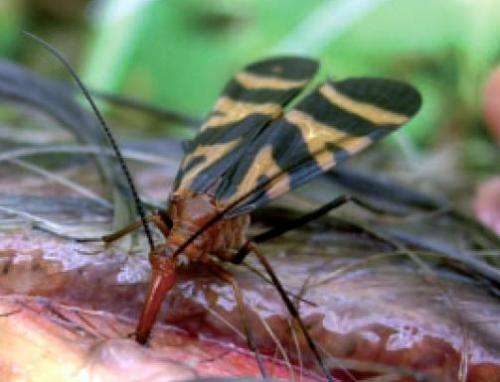New forensic entomology observations expand knowledge of decomposition ecology

Fans of CSI: Crime Scene Investigation and similar TV shows know that forensic entomology involves the use of insects and other arthropods in legal matters, including homicide cases. Entomologists who are properly trained can find clues about a corpse—for example, time of death and whether a body has been moved—by observing the insects on and around it.
Forensic entomologists rely on certain insects that are typically found on corpses. Blow flies, for examples, can hone in on dead animals and lay eggs within minutes, and forensic entomologists can gather clues by examining the developmental stages of the larvae and the pupae. Dermestid beetles are also associated with dead bodies. In fact, their larvae are sometimes used by museums and by taxidermists to strip the flesh off of bones.
A new study published in the Journal of Medical Entomology shows that other insects—ones that are not normally associated with human corpses—also interact with dead bodies, which may provide more clues for forensic entomologists in the future.
As part of her master's thesis, Natalie K. Lindgren, a student at Sam Houston State University, studied cadavers at the Southeast Texas Applied Forensic Science facility and made some unusual observations. In two of the case studies, the researchers observed insect interactions that had not been previously documented on human cadavers. In the first one, scorpionflies (Panorpa nuptialis) were the first insects to feed upon a freshly placed cadaver.
"It's significant that Panorpidae (scorpionflies) were the first insects to feed upon a freshly-placed corpse," said Dr. Jason Byrd, President-Elect of the North American Forensic Entomology Association, who was not involved with the research. "Entomologists rely on insect succession to help them determine portions of the postmortem interval, and having a study that indicates that Panorpidae are early-arriving species will certainly assist forensic entomologists in their investigations."
In another case, Natalie and her colleagues saw a caterpillar (Spodoptera latifascia) in the family Noctuidae chewing and ingesting dried human skin.
"The report of the noctuid caterpillar found chewing and ingesting dried human skin is interesting because we need to interpret the various postmortem artefacts that manifest on human remains," said Dr. Byrd. "Roaches, ants, crayfish, starfish, bees, and wasps all leave characteristic markings as a result of their scavenging behavior. Knowledge that a noctuid is an opportunistic scavenger will be beneficial to entomologists because the pattern of scavenging is likely different than that of other insects, and it should not be accidentally attributed to a pattern injury from a human perpetrator."
More information: The full article, "Four Forensic Entomology Case Studies: Records and Behavioral Observations on Seldom Reported Cadaver Fauna With Notes on Relevant Previous Occurrences and Ecology," is available at jme.oxfordjournals.org/lookup/ … i/10.1093/jme/tju023
Journal information: Journal of Medical Entomology
Provided by Entomological Society of America




















